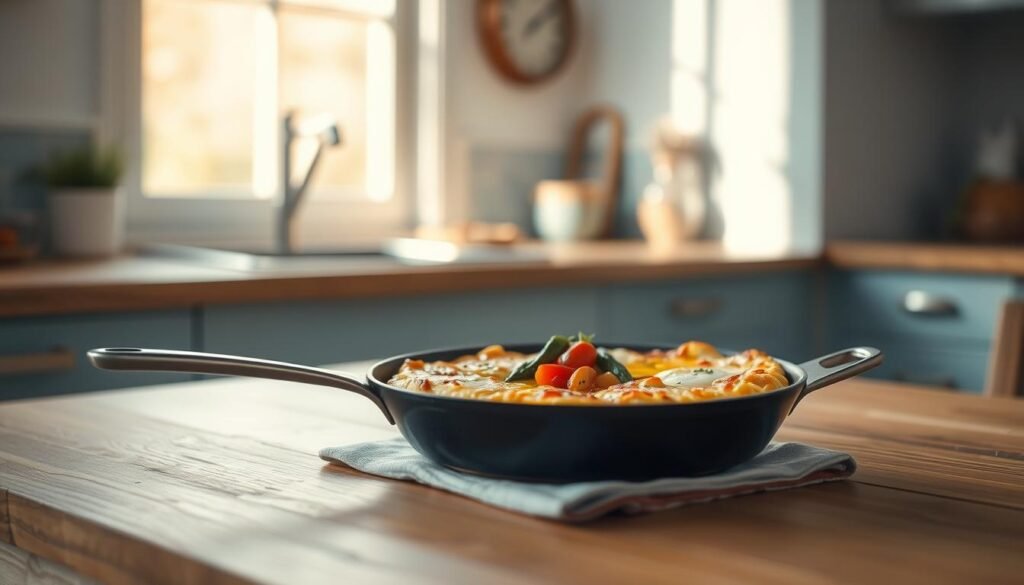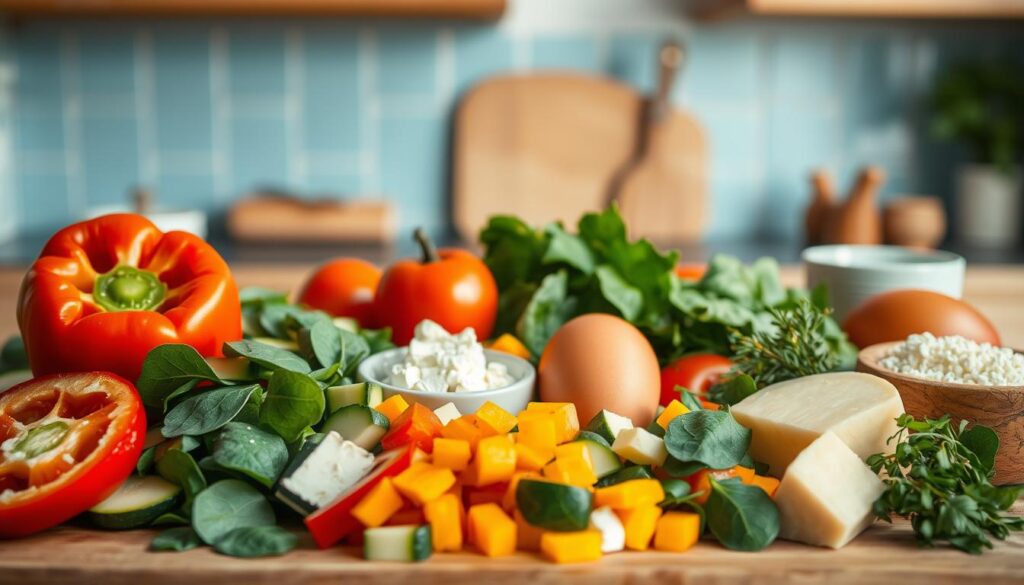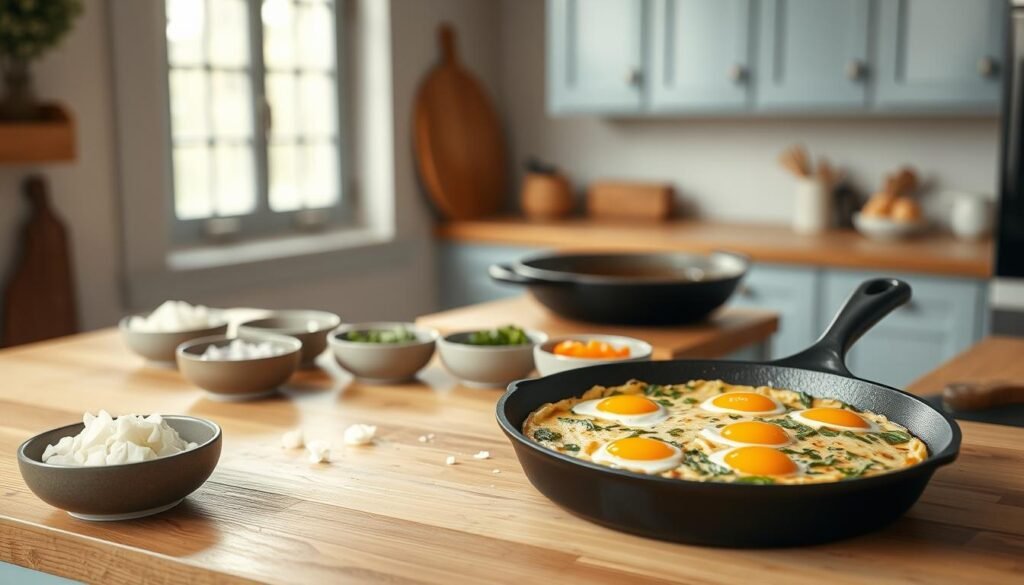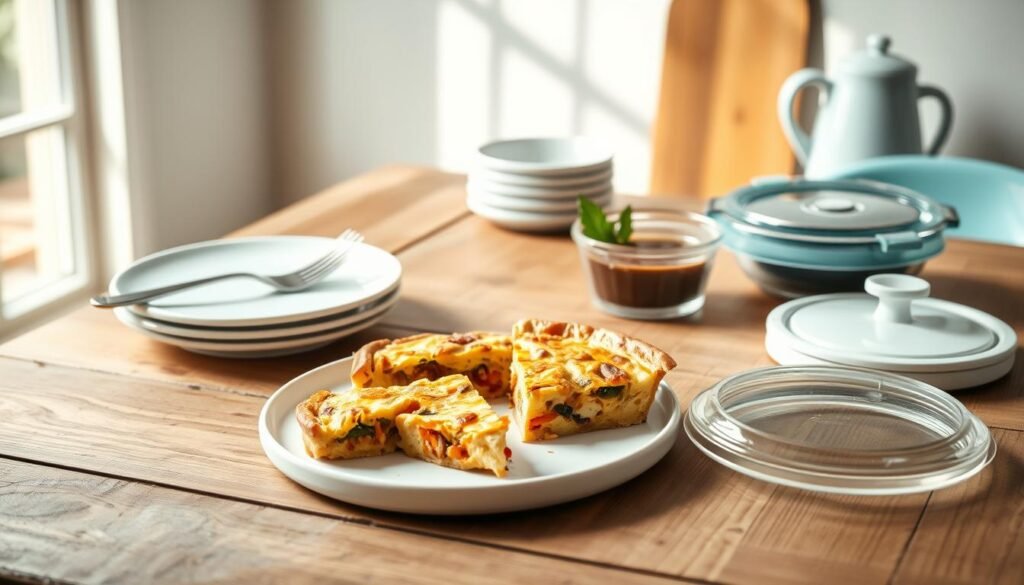Low Sugar Breakfast Frittata Recipe With Seasonal Vegetables
Looking for a healthy breakfast idea? My low sugar breakfast frittata recipe is a simple, veggie-packed solution to morning meals.
What if your morning meal could be both nourishing and effortless? I’ve burned more rushed omelets than I’d care to admit before landing on this formula—a golden, veggie-packed dish that adapts to whatever’s fresh at the market. Think zucchini blossoms in July, sweet potatoes in November, or asparagus in spring. It’s become my go-to when time feels scarce but flavor can’t be.
This version skips added sweeteners entirely, letting natural veggie sugars shine. You’ll need just six core ingredients: a handful of seasonal produce, a splash of olive oil, and those trusty large eggs from your fridge. I’ve served it warm to family and cold to meal-prep clients—both ways earn nods. The magic? It’s forgiving. Overcooked the edges? Call it “caramelized.” Forgot the cheese? Herbs save the day.
- Balances fresh flavors with simple prep—no fancy tools required
- Works with nearly any vegetable combination you have on hand
Understanding the “low sugar breakfast frittata recipe”
Ever stared into your fridge wondering how to turn random veggies into something satisfying? That’s where this egg-based skillet meal shines. Unlike omelettes needing constant attention or quiches requiring pastry patience, it’s a no-fuss canvas for whatever needs using up.

The Shape-Shifter of Egg Dishes
I once burned a quiche because I forgot the crust timer. Lesson learned: frittatas forgive. They’re essentially crustless quiches that transition from stovetop to oven effortlessly. Here’s how they stack up:
| Texture | Cooking Method | Prep Time | |
|---|---|---|---|
| Omelette | Soft folds | Stovetop only | 5 mins |
| Quiche | Custardy | Oven-baked | 45+ mins |
| This Dish | Fluffy & firm | Skillet-to-oven | 20 mins |
Nourishment Without the Numbers Game
A client once asked me, “How do you make veggies taste good without dressing them in sugar?” My answer: let their natural sweetness lead. Summer cherry tomatoes caramelize beautifully in a preheated skillet, while winter squash softens into subtle sweetness. You’re getting fiber and nutrients without added sweeteners—just what your morning energy needs.
Medium heat is key here. Too hot, and eggs turn rubbery. Too low, and you’ll miss those golden edges. I test the skillet with a water droplet—if it sizzles calmly, you’re ready. Last week, I threw in radish greens and leftover roasted carrots. Result? Zero complaints from my carb-loving teen.
Essential Ingredients and Preparation Overview
Gathering the right components transforms this dish from simple to memorable. Let’s break down what works—and why certain choices make all the difference.

Fresh Vegetables and Seasonal Picks
Last spring, I overloaded a skillet with asparagus—then realized I hadn’t cracked enough eggs. Lesson learned: aim for 2 cups chopped veggies per 8 large eggs. My current favorites?
- Summer: Zucchini ribbons + cherry tomatoes
- Fall: Roasted butternut squash + kale
- Winter: Caramelized onions + rainbow chard
| Pan Type | Veggie-to-Egg Ratio | Cooking Time |
|---|---|---|
| Cast Iron | 1:4 | 18-20 mins |
| Non-Stick | 1:5 | 15-17 mins |
| Ceramic | 1:3.5 | 20-22 mins |
Eggs, Dairy, and Flavor Enhancers
Whisk 8 large eggs with ¼ cup milk—whole milk adds richness, almond milk keeps it light. For every cup of veggies, I add:
- 1 minced garlic clove (sautéed first)
- ½ tsp cracked pepper
- Pinch of sea salt
Crumbled feta or goat cheese melts beautifully into the mixture. Need inspiration? These make-ahead breakfast egg muffins use similar principles for busy mornings.
Ensure vegetables are evenly chopped for consistent cooking, allowing even heat distribution and avoiding undercooked spots in your frittata.
Step-by-Step Cooking Instructions
Remember that time you tried flipping an omelette and ended up with scrambled eggs? This method skips the stress. Preheat your oven to 375°F while prepping ingredients—it’ll be your safety net for perfect doneness.

Sauté, Assemble, and Transition to Oven
Start with 2 tablespoons of olive oil in your skillet over medium heat. Sauté chopped veggies until tender—about 5 minutes for zucchini, 7 for root vegetables. Whisk 8 eggs with ¼ cup milk, minced garlic, and a pinch each of salt and pepper. Pour the mixture evenly over the vegetables, gently shaking the pan to distribute.
Cook undisturbed for 3 minutes until edges set. Transfer the skillet to the oven immediately. Bake 12-15 minutes until the center barely jiggles. Cast iron works best here—it retains heat without scorching, unlike thinner pans.
Tips for Achieving the Perfect Texture
Resist the urge to stir once the eggs hit the pan. That initial undisturbed cooking creates a stable base. If your oven runs hot, check at 10 minutes—overbaking turns eggs rubbery. Not setting? Leave it in 2 more minutes, then rest 5 minutes before slicing.
For meal prep mornings, pair this with freezer-friendly French toast—both reheat beautifully. Leftovers keep 4 days refrigerated or 3 months frozen. Simply warm slices in a toaster oven to revive the texture.
Be mindful not to overcook the frittata. Overbaking can lead to rubbery texture—monitor it carefully to achieve the perfect fluffiness.
Frittata Variations and Customization Ideas
My neighbor once swapped my basil for dill mid-recipe—turns out, happy accidents make the best flavor combos. That’s the beauty of this dish: it thrives on creativity. Whether you’re clearing out the crisper or craving something new, these ideas will spark your kitchen experiments.

Veggie & Herb Playbook
Try roasted red peppers with goat cheese and thyme—their earthy sweetness pairs perfectly. For a Mediterranean twist, fold in kalamata olives and artichoke hearts. If you’re using delicate greens like spinach, add them raw just before baking. Heartier kale? Sauté it first with garlic.
Crumbled feta loves cherry tomatoes. Try this combo: toss halved tomatoes in your skillet until blistered, then sprinkle cheese over the egg mixture. Prefer broccoli? Roast florets first for nutty depth. Pair either with fresh dill or oregano.
Stick to 2 cups veggies per 8 eggs for ideal texture. Need inspiration? These low-carb breakfast solutions follow similar principles. Swap herbs based on season—basil in summer, rosemary in winter. Even a pinch of smoked paprika can reinvent leftovers.
Remember: your cast iron skillet is your ally. Its even heat distribution prevents burning when testing new combos. Once baked, let it rest 5 minutes—patience rewards you with clean slices. No oven-safe pan? Finish cooking covered on low heat.
If using delicate greens, add them last to avoid wilting or sogginess. Overcooking can compromise both texture and flavor balance.
Serving, Storing, and Reheating Best Practices
Hosting brunch last month taught me a crucial lesson: presentation matters as much as taste. A client once mistook my carefully arranged slices for bakery quiche—until they took a bite. Now I focus on simple tricks that elevate this dish from fridge staple to centerpiece.

Brunch Magic Made Simple
Use a pizza cutter for clean wedges. Arrange them on a slate board with lemon wedges and fresh dill sprigs. For individual portions, layer slices over peppery arugula with a swipe of garlic yogurt. Leftovers? Tuck them into whole-grain wraps with spinach for grab-and-go lunches.
| Storage Method | Duration | Reheating Instructions |
|---|---|---|
| Refrigerator | 5 days | Microwave 30-40 seconds |
| Freezer | 3 months | Oven at 350°F for 10-12 minutes |
Freeze portions between parchment paper—they’ll separate easily. My kids prefer theirs cold, straight from the container. For best texture, reheat refrigerated slices uncovered. Burnt edges? Crumble them into breakfast hash.
Pair with massaged kale salad or roasted sweet potatoes. Last week, I topped wedges with quick-pickled radishes. The crunch transformed day-old eggs into something special. Remember: proper storage keeps flavors bright. Your future self will thank you during hectic mornings.
Reheat leftovers carefully. Overheating in the microwave can turn the frittata rubbery and dry. Aim for low, gentle heat to maintain texture.
Kitchen victories don’t need complexity—just a trusty skillet and whatever’s in season. This egg-based dish thrives on simplicity: sauté vegetables in olive oil, pour in the seasoned mixture, and let the oven work its magic. Cast iron ensures golden edges every time, while flexible ingredients let your fridge leftovers shine.
I’ve served this with caramelized cherry tomatoes in August and roasted squash in December. Swap spinach for kale, crumbled feta for cheddar, or milk alternatives based on what you’ve got. The 20-minute bake time? More guideline than rule—adjust by pan size. Leftovers become tomorrow’s sandwich filler or salad topper.
Try it this weekend. Tag @Prepistry with your creation—I’d love to see your twist. Hungry for more? Explore our breakfast recipes that celebrate real ingredients without fuss. Here’s to meals that adapt to your rhythm, not the other way around.
Seasonal Veggie Frittata
A light and fluffy frittata made with fresh, seasonal vegetables. Perfect for busy mornings or meal prep.

Nutrition Information
Equipment Needed
- Skillet
- Whisk
- Oven-safe dish
Ingredients
-
8 large eggs
-
2 tbsp olive oil
-
1 cup zucchini, chopped
-
1 cup cherry tomatoes, halved
-
1/2 cup onion, diced
-
1/4 cup fresh basil, chopped
-
1/4 cup crumbled feta cheese
-
Salt and pepper, to taste
Instructions
Recipe Video
Lunch's Best Friend: Seasonal Vegetable Frittata
A seasonal vegetable frittata is the BEST way to get extra vegetables into your breakfast. I am obsessed with this recipe because once you get the technique down, you can make it your own with any vegetables you have on hand.


